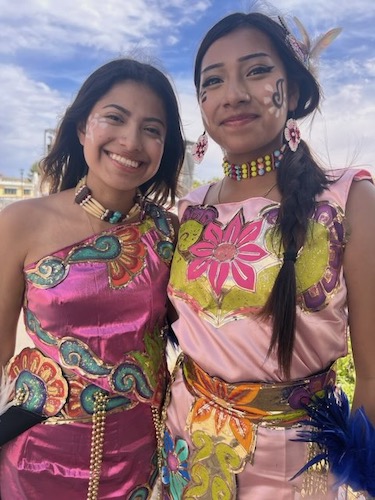Photos, video and article by Cara Staab From left, Laisha Vargas Garcia, a WNMU President's List student, with her sisterÂ
From left, Laisha Vargas Garcia, a WNMU President's List student, with her sisterÂ
Tiffany Vargas Garcia, who also performs with the Kaltonaka Dance Group.
Kaltonaka Dance Group (Chichimeca Mexica Azteca) performed an Aztec ceremonial dance program Saturday at the Latina Festival. The dancers wore Aztec regalia that often included feather headdresses and leg rattles. The group is based out of northern New Mexico, but one of its members, Laisha Vargas Garcia, is a President's List student at WNMU.
Laisha's response when asked what is "Chichimeca Mexica Azteca," which is in their header name:
"chichimeca mexica azteca" is basically all referring to our people and our ancestors. our ancestors used to be known through all of those names "chichimecas" "mexicas" (pronounced meh-shee-kahs) and "aztecas, she said."
"Chichimecas were the different groups of peoples who first established themselves in what was known as Aztlán/ Tenochtitlán known as current day Mexico City.
"The chichimecas eventually turned into the Aztec Empire with famous emperors such as Montezuma II.
"Mexicas, were the peoples who separated themselves from the Aztec Empire later on. All in all, they are all the same people and they all mean the same thing," she concluded.
The story of each dance was explained by  narrator, so that the audience could understand the meaning and cultural significance. In one dance about overcoming the hardships of life, the dance group called upon part of the audience to form a convoluted serpentine chain that eventually unwound through movement and became a united circle. Dozens more festival attendees watched from the tables and lawn surrounding the dance floor.
Drums, maracas, and leg rattles played and worn by various dance group members provided the beat for all dance songs.The Kaltonaka Dance Group opened and closed their Aztec dance program with an incense ceremony to the four elements of the earth.Â
Griselda Garcia, Laisha Vargas Garcia's mother, crafted the garments worn by herself and the other members of the dance group, including her daughter Laisha .
Jose Vargas performed as "The Jaguar." Vargas is Laisha's father.
Aztec leg rattles (called huesos) were worn by most of the dancers, accenting the beat set by other group members who were hand drumming .
To pause the slide show, mouse over the image.









